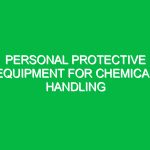Introduction
The safe storage of hazardous materials is a critical aspect of health, safety, and environment (HSE) management. These materials, which can include chemicals, biological agents, and radioactive substances, pose significant risks if not properly handled and stored. The topic might seem daunting, but understanding the essentials of safe storage can mitigate potential hazards, protect workers, and ensure compliance with regulations.
In my years working in industrial environments, I’ve seen firsthand the consequences of improper storage. A colleague once recounted an incident in a chemical plant where a leaking drum of corrosive material led to a significant evacuation. Fortunately, no one was harmed, but the event served as a stark reminder of the importance of proper storage practices. This article aims to provide a thorough understanding of the safe storage of hazardous materials, including risks, best practices, and regulatory requirements.
Understanding Hazardous Materials
Before delving into storage practices, it’s essential to define what constitutes hazardous materials. According to the Occupational Safety and Health Administration (OSHA), hazardous materials are any substances that can pose a threat to health or the environment. This broad category includes chemicals that are flammable, corrosive, reactive, toxic, or harmful in other ways.
Identifying Hazards and Risks
The storage of hazardous materials comes with a plethora of risks. Identifying these hazards is the first step toward effective management. Here are some of the most common hazards associated with hazardous materials storage:
1. Chemical Reactions
When incompatible materials are stored together, they can react violently. For example, storing acids near bases can lead to neutralization reactions that produce heat and potentially explosive gases.
2. Fires and Explosions
Flammable materials must be stored with care. A small spark or open flame can ignite vapors, leading to hazardous fires or explosions. In one notable case, an improperly stored can of paint thinner ignited in a warehouse, causing extensive damage and injuries.
3. Leaks and Spills
Containers can corrode, rupture, or otherwise fail, leading to leaks or spills. Depending on the material, this can result in contamination of the environment or pose serious health risks to workers.
4. Toxic Exposure
Exposure to hazardous materials can occur through inhalation, skin contact, or ingestion. For instance, improperly stored pesticides can release harmful vapors, affecting not just workers but also nearby populations.
5. Environmental Damage
Inadequate storage of hazardous materials can lead to environmental contamination. This is particularly critical in industries where materials may leach into soil or water sources, affecting ecosystems and human health.
Safety Precautions for Safe Storage
Now that we’ve identified the risks, let’s explore safety precautions and best practices for the safe storage of hazardous materials. Implementing these measures can significantly reduce the likelihood of incidents.
1. Proper Labeling
Every hazardous material should be clearly labeled with its contents, hazard symbols, and appropriate handling instructions. This ensures that anyone who interacts with these materials understands the risks involved. For example, the Globally Harmonized System of Classification and Labelling of Chemicals (GHS) provides standardized labels that can be recognized universally.
2. Segregation of Incompatible Materials
Incompatible substances must be stored separately to prevent dangerous reactions. For instance, oxidizers should be stored away from organic materials and flammable substances. A practical approach is to use color-coded storage bins to aid in quick identification.
3. Use of Appropriate Containers
Containers must be suitable for the type of hazardous material being stored. For corrosive substances, use containers made of materials resistant to corrosion. Always inspect containers for damage before use, and replace any that show signs of wear.
4. Temperature Control
Many hazardous materials require specific temperature conditions for safe storage. Flammable liquids, for example, should be kept in cool environments to minimize vapor production. Using climate-controlled storage areas can help manage these risks effectively.
5. Adequate Ventilation
Proper ventilation is crucial, especially in areas where volatile substances are stored. This reduces the accumulation of harmful vapors and gases. Installing fume hoods or exhaust systems can aid in maintaining air quality.
6. Regular Inspection and Maintenance
Regularly inspect storage areas and containers for leaks, corrosion, or any signs of degradation. Establish a routine maintenance schedule to ensure that any issues are identified and addressed promptly.
7. Training and Emergency Preparedness
All personnel who handle hazardous materials should undergo comprehensive training that includes storage practices, emergency response procedures, and the use of personal protective equipment (PPE). Conducting regular drills can prepare employees for potential emergencies.
Regulatory Standards and Compliance
Understanding the regulations governing the safe storage of hazardous materials is essential for compliance and safety. Various organizations set forth guidelines that must be adhered to in order to mitigate risks.
1. OSHA Standards
OSHA provides specific regulations concerning the storage of hazardous materials, particularly in 29 CFR 1910.106, which deals with the storage and handling of flammable and combustible liquids. Employers must comply with these standards to ensure workplace safety.
2. Environmental Protection Agency (EPA) Regulations
The EPA enforces regulations aimed at preventing environmental contamination from hazardous materials. The Resource Conservation and Recovery Act (RCRA) outlines how hazardous waste must be stored and disposed of, emphasizing the importance of safe storage practices.
3. National Fire Protection Association (NFPA) Codes
The NFPA establishes codes and standards for fire safety, including the storage of hazardous materials. Their guidelines help organizations implement effective fire prevention measures and ensure that flammable materials are securely stored.
Case Studies: Lessons Learned
Real-world examples can provide invaluable insight into the importance of proper hazardous material storage. One notable incident occurred at a manufacturing facility where improper storage of flammable liquids resulted in a devastating explosion. The investigation revealed that the materials were stored in a non-ventilated area without proper segregation. This incident not only caused extensive damage but also led to a reevaluation of safety protocols in the entire industry.
In contrast, a chemical company that implemented a comprehensive storage program saw a significant reduction in incidents. By training employees, updating storage facilities, and adhering strictly to regulations, they created a safer work environment. This commitment to safety not only protected employees but also improved their reputation and reduced insurance costs.
Conclusion
The safe storage of hazardous materials is not just a regulatory requirement; it is a moral obligation to protect employees, the environment, and the community. By understanding the risks, implementing best practices, and adhering to regulations, organizations can create a safer workplace.
Remember, safety is not a one-time effort but an ongoing commitment. Regular training, inspections, and updates to procedures are key to maintaining a safe storage environment for hazardous materials. In the ever-evolving landscape of health, safety, and environment, vigilance and proactive measures can make all the difference.


